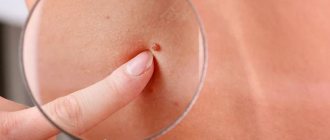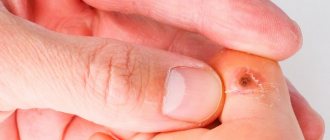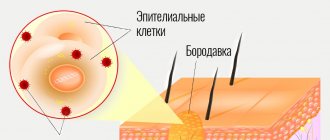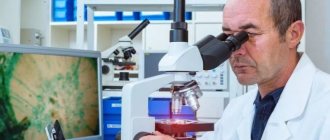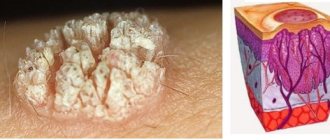Proponents of alternative treatment believe that treating papillomas with hydrogen peroxide is the most effective and efficient method of combating these benign neoplasms. In addition, the drug has proven itself well in removing warts. However, in order to get positive results from using peroxide to remove skin growths, you need to comply with several conditions and take into account that the therapy will be long and will require a lot of patience and perseverance.
Hydrogen peroxide is an affordable and effective remedy for the treatment of papillomas.
Types and reasons
Warts are:
There are a lot of varieties of warts; they are classified according to a number of characteristics:
- Simple. They occur on exposed parts of the body, arms, legs, face, and scalp. They are usually not dangerous, but they are not aesthetically pleasing and can multiply quickly, affecting large areas of the skin. They are arranged as if in “families”.
- Plantar. Their localization is exclusively on the feet. Causes discomfort when walking.
The main cause is infection with the human papillomavirus, which affects the mucous membranes and skin.
External use of peroxide for warts and papillomas
To get rid of skin growths using hydrogen peroxide, you need to apply 1 drop of the solution to the top of the wart or papilloma several times every day. You can moisten a cotton swab with peroxide and wipe the benign formation with it, and after 7-14 days there will be no trace of the growth left. Proponents of alternative treatment suggest making peroxide compresses by soaking a piece of gauze in it and applying it to the problem area of the skin. The compress is fixed with an adhesive plaster and the procedure is repeated every 2–2.5 hours. After 3-4 days, the papilloma will fall off on its own.
A recipe made from hydrogen peroxide in combination with oak bark is effective in combating skin growths. To prepare it you will need:
- pour 100 milliliters of boiling water over the oak bark;
- leave to infuse for 24 hours;
- drain the water and mix the resulting mass with a tablespoon of hydrogen peroxide;
- Mix the ingredients thoroughly and place in a glass container;
- store in the refrigerator;
- apply to the growth three times a day, covering the top with film;
- leave for 30 minutes, then rinse with warm milk;
- The duration of the course is 3 weeks or less if the formations disappear from the skin earlier.
Human papillomavirus
This is one of the most common viruses on Earth. Infection can occur in several ways:
- contact and household (through touch);
- sexual (genital, anal, oral-genital);
- in childbirth from mother to child.
The period of development of the disease ranges from several weeks to tens of years, this is explained by the fact that the virus may not manifest itself for a long time, but as soon as the immunity becomes a little weaker, growths immediately appear on the skin and/or mucous membranes. The main danger of this disease is that certain types of HPV are highly likely to cause the formation of a malignant tumor (cancer of the skin or mucous membranes). To make sure that the disease will not lead to the formation of a tumor, it is necessary to undergo examination by a doctor and not self-medicate.
Hydrogen peroxide
25 ml, 40 ml, 50 ml, 90 ml, 100 ml in glass bottles with a screw neck, sealed with plastic stoppers and screw caps.
25 ml, 40 ml, 50 ml, 90 ml, 100 ml in polyethylene bottles for medicines made of low-density high-density polyethylene, complete with a tamper-evident lid made of low-density high-density polyethylene.
25 ml, 40 ml, 50 ml, 90 ml, 100 ml in polyethylene polymer bottles, sealed with polyethylene polymer stoppers and polyethylene polymer screw caps.
Labels made of label or writing paper or paper or self-adhesive labels are glued onto the bottles.
Each bottle, along with instructions for use, is placed in a pack of boxed or chrome-ersatz cardboard.
70 bottles of 25 ml or 70 bottles of 40 ml or 70 bottles of 50 ml or 40 bottles of 90 ml or 40 bottles of 100 ml, packed in polyethylene shrink film or in boxes with partitions or grids made of corrugated cardboard along with an equal number of instructions for use (for hospitals).
Labels made of label or writing paper or paper or self-adhesive labels are glued onto packaging made from polyethylene shrink film.
500 ml, 1000 ml in polyethylene polymer bottles, sealed with polyethylene polymer stoppers and screw-on polymer polyethylene caps (for hospitals).
Labels made of label or writing paper or paper or self-adhesive labels are glued onto the bottles.
12 bottles of 500 ml each or 8 bottles of 1000 ml each, packaged in polyethylene shrink film or in boxes with partitions or grids made of corrugated cardboard along with an equal number of instructions for use for hospitals).
10 kg, 20 kg in polyethylene canisters made of high-density polyethylene of low pressure.
Labels made of label or writing paper or paper or self-adhesive labels are glued onto the canisters.
Each instruction for use is placed in a polyethylene bag.
4 canisters together with an equal number of instructions for use, placed in polyethylene bags, are packed in polyethylene shrink film (for hospitals).
Labels made of label or writing paper or paper or self-adhesive labels are glued onto packaging made from polyethylene shrink film.
Symptoms and types of warts on the foot
A plantar wart appears as a callus-like thickening with a stratum corneum layer of skin. It interferes with walking and causes pain. The passive state is characterized by slow reproduction, not reaching the stratum corneum of the epithelium, so this condition does not manifest itself externally.
The active state is characterized by the fact that the virus develops rapidly and, rising to the upper layers of the epidermis, manifests itself in numerous symptoms. The plantar wart is also called the spinous wart, chicken wart. The virus enters during its contact with the skin through cuts and abrasions in the outer layer of the skin:
- First, a small yellowish-gray papule with an uneven surface appears.
- Gradually, the small element becomes dense and acquires a dirty color.
From the inside, a plantar wart looks like fused papillae of different sizes with a pinkish tint. Additional capillary vessels form there, causing bleeding if you catch a wart.
Therapy according to Neumyvakin
Removal of papillomas and warts using the method of Academician I. P. Neumyvakin involves the oral use of hydrogen peroxide according to a certain algorithm. According to Doctor of Medical Sciences Ivan Pavlovich, peroxide increases the defenses of the human body and helps dilute blood fluid. Neumyvakin suggests drinking hydrogen peroxide against papillomas and other skin tumors as follows:
| Period | Recipe | Dosage |
| Day 1 | Dilute a drop of hydrogen peroxide with 1/4 cup of purified water | Take three times a day during meals |
| 2nd day | Dilute 2 drops of peroxide in 50 ml of water | Divide the serving into 3 doses per day and consume with meals. |
| 3rd day | Mix 3 parts of H2O2 with 50 ml of boiled warm water | Drink in the morning, lunch and evening, dividing the daily portion into equal parts |
| 4-10th day | The number of droplets increases by one every day, while the volume of water remains unchanged | Divide the daily dose equally and consume it for breakfast, lunch and dinner. |
Those who have chosen the Neumyvakin method for removing papillomas and warts should take one nuance into account. The professor's theory has not received official recognition in traditional medicine and certified doctors categorically do not recommend consuming peroxide orally. Therefore, before starting a course with this remedy, you need to consult with a specialized physician on the selection of medications to boost the immune system and the advisability of using peroxide to get rid of unwanted growths on the epidermis.
A solution for treatment and compresses against warts is made based on hydrogen peroxide.
Removal of plantar warts
It is worth treating a plantar wart if:
- There are painful sensations.
- The wart is bleeding.
- There were spots on it.
- The wart quickly increases in size.
There are many treatment methods. One of them is cryodestruction. The meaning of the method is that the wart is exposed to liquid nitrogen at a temperature of minus 196 degrees. The virus-affected area is frozen and the wart is removed.
The usual and aggressive method of exposure is used. With the aggressive method, nitrogen is applied for a few seconds longer, but this method is more painful. It is important to note that if a wart appears and exists for more than six months, then the effectiveness of cryodestruction is greatly reduced, and the meaning of such an operation, accordingly, also disappears.
After removing a plantar wart using liquid nitrogen, you should follow some recommendations:
- the blister remaining at the site of the wart cannot be opened;
- to avoid mechanical damage, use a sterile bandage rather than a plaster;
- Treat the affected area with salicylic alcohol 2% twice a day;
- try to prevent water from entering the affected area.
Another method is laser coagulation. This is one of the most common methods for removing warts. Most laser systems are equipped with a special cooling system. Thus, the procedure takes place with minimal discomfort and does not allow inflammation, since the laser has antiseptic properties. Moreover, this is a non-contact method.
There are several ways:
- Carbon dioxide (CO2) laser. Treatment in this case occurs using infrared light. The method is 70% effective, but the downside is that healthy tissue can also be damaged.
- Erbium laser. This treatment method uses a shorter wavelength, which reduces the likelihood of scarring after surgery. Efficiency is typically 75%.
- Pulsed dye laser. With this method of exposure, the primary destruction of dilated capillaries in the wart and stimulation of the immune system, which contributes to effective healing. The effectiveness of treatment is about 95%.
After laser treatment, a crust forms on the affected area, which disappears on its own within seven to ten days. The recommendations for this method of treatment are the same as after exposure to nitrogen - avoid mechanical damage and ingress of water.
The next way to remove warts is electrocoagulation. In this case, a high frequency current is applied to the wart. Treatment is carried out under local anesthesia. Exposure of a wart to high temperatures leads to the evaporation of cells affected by the papilloma virus. Another advantage of this method is that cauterization of blood vessels prevents bleeding. After surgery, a crust forms on the affected area of the skin, which disappears within 7 to 10 days.
A plantar wart can be treated with direct surgery. In this case, excision occurs under local anesthesia, then sutures are applied. After the operation, the doctor will prescribe certain recommendations. Thus, it is recommended to prevent water and soap from entering the affected area, not to tear off the resulting crust, and to treat the affected area with an antiseptic in the first 7-10 days.
For each type of operation there are certain contraindications. Thus, it will be impossible to perform the operation if the following occurs:
- pregnancy;
- diabetes;
- malignant tumors in the body;
- infection and inflammation around the wart;
- exacerbation of herpes;
- elevated temperature.
If your blood pressure is high, the procedure should also be postponed.
General information
Chemical antiseptic - hydrogen peroxide (Hydrogen Peroxide, hydrogen peroxide, H2O2) is a liquid that is colorless and has a casual, light, sour odor. It is used to disinfect wounds, scratches and other damage to the skin of various origins. It is widely used in medicine for treating skin due to its actions, which are described in the table.
| pharmachologic effect | Description |
| Disinfectant | Clears damage to the epidermis thanks to a large amount of foam from oxygen bubbles |
| Antimicrobial | Has a detrimental effect on the reproduction and growth of pathogenic bacteria |
| Hemostatic | Stops bleeding from small wound vessels |
| Antiseptic | Exhibits an oxidative reaction, under the influence of which particles of pus are broken down and polluting particles are destroyed |
The action of the drug is used to remove cosmetic defects of the epidermis such as papillomas and warts. These are benign neoplasms, the size of which ranges from 10 to 20 mm, and can be localized in various parts of the body, but most often they appear on the arms, feet, face, back and neck. They are caused by human papillomavirus, which is present in 75% of the world's population, but is in an inactive state. HPV can be activated by various factors: taking medications, hypothermia or stress.
But why is it recommended to use hydrogen peroxide to remove papillomas and warts? Like any antiseptic solution, peroxide acts on pathogenic microorganisms that have settled in the cells of the dermis. Therefore, when in contact with skin growths, H2O2 breaks down into O and H20 and destroys the structures of benign neoplasms.
What is the advantage over other medicinal products?
Alternative healers choose hydrogen peroxide for warts and papillomas for a reason. Among the many products for removing skin growths, hydrogen peroxide stands out for the following advantages:
- has a low cost, which is affordable for anyone who wants to remove a wart;
- can be used in childhood, as it eliminates the possibility of causing serious harm to health;
- safe for pregnant and nursing mothers;
- does not cause side effects or pain when applied to damaged skin;
- shows high effectiveness in treatment;
- can be used externally and internally.
Academician Neumyvakin developed a method for getting rid of warts using peroxide orally.
